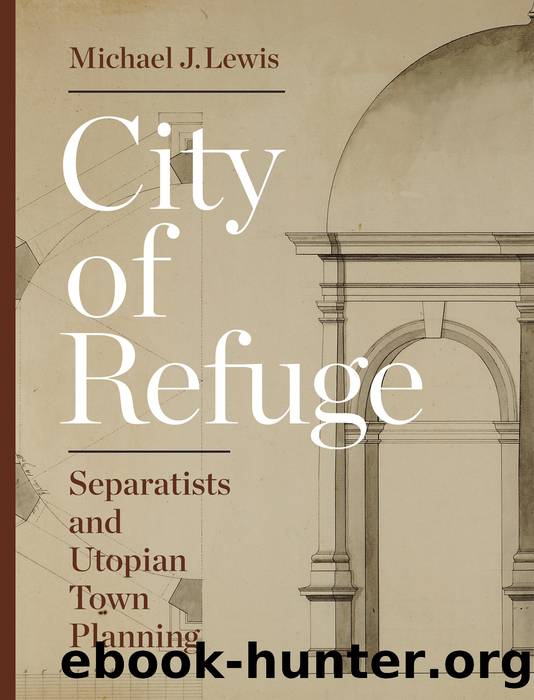City of Refuge by Lewis Michael J.;

Author:Lewis, Michael J.; [Lewis, Michael J.;]
Language: eng
Format: epub
ISBN: 9780691171814
Publisher: PrincetonUP
Published: 2016-07-15T05:00:00+00:00
FIG. 88 The third and final Harmonist labyrinth at Economy was in a park outside the town. It seems to have been Rappâs own personal plaything, and once he died in 1847, it was neglected and soon vanished.
A final Harmonist labyrinth was built in Economy, shortly after the Harmonist return to Pennsylvania in 1825 (fig. 88). This too was âa curious labyrinth, out of which none but those who formed it, or are well acquainted with it, can find their way.â43 It survived Rappâs death by two decades; when Aaron Williams wrote his history of the Harmonists in 1866, its central pavilion was still standing, but it too has vanished without a trace.44
While all three labyrinths have been lost, one of Rappâs little âtemples emblematical of Harmonyâ does survive. This is the so-called Grotto at Economy, which, though not located at the hub of a labyrinth, otherwise shows the same juxtaposition of a forbidding exterior and delightful interior. This is placed in the garden behind Rappâs house, in the heavily wooded quadrant in the southwest. Its external materials are as deliberately crude as possible: irregular granite and sandstone boulders laid in mud mortar in seemingly haphazard fashion, with the tiniest of windows; a thickly thatched conical roof; and a door of white oak bark (fig. 89). But within was an exquisite gem of a space, neatly plastered and articulated into panels and a delicate cornice (fig. 90). Inscriptions on the wall set out the founding dates of the Harmony Society.
Rappâs curious thatched pile was hardly original: since the early eighteenth century, rustic garden pavilions had been a commonplace of picturesque garden design. Their variety was beguilingâGothic bowers, fermes ornées, all manner of spurious ruinsâbut the quirkiest was the hermitage, the crude dwelling of a hermit in the woods. (In the more extreme cases, English estate owners are known to have engaged âornamental hermitsâ to occupy them, their principal duty being to look picturesque.) The German word for hermitage is Einsiedelei, which can also mean the settlerâs first cabin in the wilderness, a notion that had additional resonance for Germans moving into the American frontier.
Download
This site does not store any files on its server. We only index and link to content provided by other sites. Please contact the content providers to delete copyright contents if any and email us, we'll remove relevant links or contents immediately.
The Switch by Beth O'Leary(1289)
Sisters by Daisy Johnson(1251)
The Enemy by Sarah Adams(1209)
Guard Duty by Sharon Dunn(991)
The Christmas Killer by Alex Pine(935)
The Chronicles of Narnia -Complete Series- by C. S. Lewis(891)
Explosive Situation by Terri Reed(869)
Alaskan Showdown by Sarah Varland(840)
The Ruthless Billionaire by Evangeline Kelly(798)
Dangerous Women by Hope Adams(779)
Fans Only by B. Love(752)
The Heart's Song by Winnie Griggs(714)
Valley of Shadows by Shirlee McCoy(704)
TRUTH by James Crow(688)
Truth of the Divine by Lindsay Ellis(685)
Nine by Rachelle Dekker(657)
World's End by Ed James(645)
Forget Me Not by Sarah M. Eden(586)
Kill Order by Adam Blumer(584)
